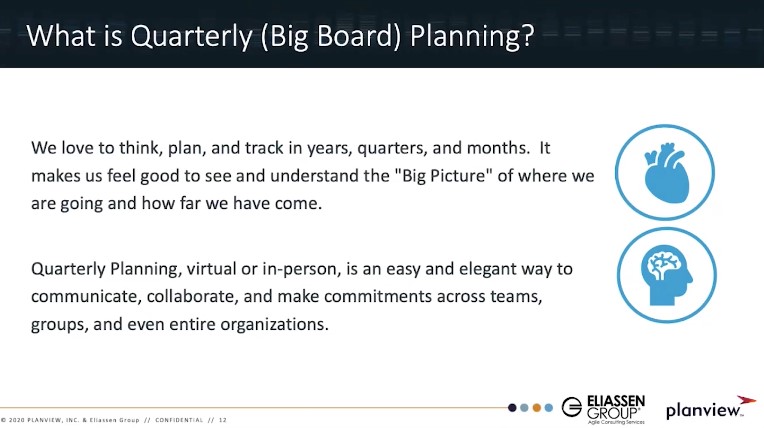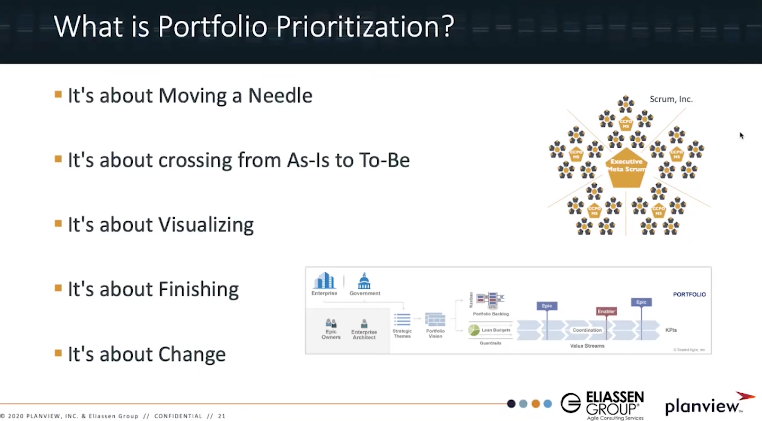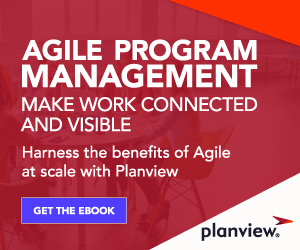
Webinar Highlights
In a recent webinar, “Agile Program Management from the Trenches”, I had the opportunity to participate with a panel of experts from Eliassen Group on the ways organizations can approach scaling Agile across their teams. We tackled complex topics like horizonal vs. vertical scaling, big board planning (AKA program increment (PI) planning in SAFe), and portfolio prioritization. This blog showcases some of the notable highlights you will want to review in the webinar, frequently asked questions, and recommendations to consider as you mature your Agile program. Let’s jump in.
Horizontal vs. vertical scaling Agile
What are horizontal and vertical scaling?
- Horizontal scaling takes place when companies expand their use of Agile methodologies beyond its roots (usually IT or Software Development) into other teams and departments across the enterprise, like Sales, Marketing, or Human Resources.
- Vertical scaling involves scaling up through the ranks of the business to create stronger alignment and greater visibility. It facilitates effective communication from leadership down as well as healthy feedback loops going back up.
When managing a company Agile transformation, scaling horizontally is a good aspirational goal, but it’s critical to mature vertical scaling to ensure practices are embedded in culture and process.
The webinar offers two real-world case studies of clients focused on vertical scaling, including a smaller higher education company aiming to improve strategic alignment and a large financial services firm with a mature Agile practice that wanted to increase transparency, metrics, and governance.
Move from ad hoc planning to big board planning
Whether you call it big board, big room, PI or simply quarterly planning, the idea is the same.
Big board planning is not a new concept. In fact, Eliassen Group has been running big board events for more than ten years. Planning events require no training and minimal prep work. Big board planning enables teams to run capacity planning, dependency mapping, risk assessments and more to visualize workflows and identify enablers and blockers.
Listen to the webinar to see how to use Planview AgilePlace for virtual and/or in-person PI planning events. I demonstrate how Planview AgilePlace provides one view at the program-level as well as Lean and Agile metrics within the tool.

Making portfolio prioritization a priority
Portfolio prioritization can be tough for even seasoned Agile organizations. As a first step, it is important to establish ownership. Since prioritization is the key responsibility for the product side of the house, from product owner to epic owner, it’s the product team’s responsibility.
Tips and tricks from the webinar included:
- Toolkit: “If you can’t see it, you can’t manage it.” You can’t move from as-is to to-be without visibility. Portfolio Kanban is essential to visualize, manage, and analyze the flow of work from ideation to value delivery.
- Change: Embrace it. The world moves too quickly to be locked into anything for a year. Whether your framework of choice encourages change every sprint or every quarter, accept that it’s part of the prioritization process.
Check out the webinar for additional recommendations from Jim Damato, Agile Transformation Lead at Eliassen Group, including how to put portfolio prioritization into action and why it’s not as hard as people think.

Frequently Ask Questions
We received some great question during the Q&A section of the webinar. We’ve summarized them for you here:
- What approaches do you use to get an organization to agree that they need to scale Agile? Try using average loaded hourly rate to demonstrate how the annual costs for a group of employees or contractors become a much better investment if you can make people more efficient. For a team of seven people, you can regain over $350,000 per year with just 10% greater efficiency. And that’s just the beginning: good Agile teams can free up about 25% of their time on average, and organizations that implement Agile at scale can recoup 40% or more. Showing those numbers can be very effective.
- How do you strike the balance between making adaptive changes and keeping commitments? Start with longer commitments, like the quarter, but remain flexible as well. Your daily stand-up is your ability to adjust how you’re going to meet your sprint commitments, and your sprints are your chance to adjust how to meet your quarterly commitments. It’s important to recognize that if you’re not meeting commitments, you need to find out why. You never know what’s going to get in the way of meeting quarterly commitments until you’re into it, so it’s critical to adapt along the way.
- What does it take to prepare for quarterly planning meetings? How does it change when it happens virtually vs. in-person? How many teams can be represented without making things too crowded? Prep work is pretty minimal. At Eliassen Group, we ask that you bring us a list of what you’re working on that includes individual and team projects. Then you dive right in, dividing up wall space for each team and giving teams green, yellow, and pink cards. Next comes dependency mapping across teams, which helps adjust priorities. We recommend one to two days depending on the size of the group, but no group is too big – we’ve done it with 500 people! Virtual planning works very well as well, using breakout rooms and virtual walls to create the same “a ha!” moments.
From a tool perspective, it’s important to be able to visualize your plan. There is no value-add unless you come out with an agreed-upon commitment to a plan. Something like Planview AgilePlace gives you that visibility so you can make the tactile connection between walls and stickies. It goes beyond the planning session itself as well to provide ongoing value to the team. - If your organization isn’t ready for big board planning, where should you start? What is the path to get there? There are many scaling practices that teams can use to remove impediments and go faster. You can start with your own existing processes to increase collaboration from the top down. The real goal of big room planning is achieving alignment and making sure everyone is moving in the same direction. Any methods that you can put in place to meet that objective will get help on your journey.
We’re excited about the insights in this joint webinar and about our partnership with Eliassen. Working together, our teams unite cutting-edge tools with impactful coaching and services to empower organizations on their Agile journeys. With 30+ common customers under our belts, we’ve proven that we make a great team.
I invite you to watch the webinar, Agile Program Management from the Trenches, for more details on Eliassen’s coaching practice, Planview’s toolset, and how they work together.

![Agile Program Management: How to Increase Agile Scaling Success [Video]](https://blog.planview.com/wp-content/uploads/2020/09/Apm-video.gif)


